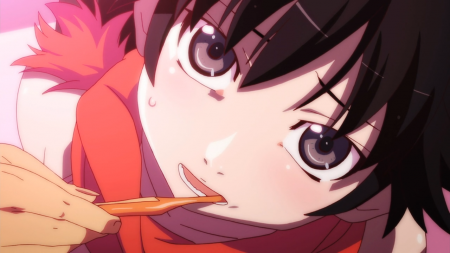Ask John: Is Nisemonogatari Episode 8’s Toothbrush a New Meme?

Question:
I just watched Nisemonogatari episode 8 and was absolutely flummoxed by what had occurred. Now many people on the web are calling this “tooth brush” scene to be one of the most infamous episodes in the past couple of years. What was your take on it, and is it truly that much of a ground breaking episode that will be remembered for years to come?
Answer:
To be honest, in order to address this question, I had to catch up on Nisemonogatari episodes 6 & 7 first, as I am watching this program but find it visually stylish but otherwise particularly dull. As of eight episodes, Nisemonogatari is merely a less interesting and far more overwraught retread of Bakemonogatari that again has Koyomi Araragi cycling through a harem of girls, sequentially helping them solve their psycho-supernatural problems. I’m absolutely not opposed to dialogue heavy anime, having watched all of Mamoru Oshii’s films & OVAs, Key the Metal Idol episode 14, and all of Kurenai, for example. However, Nisemonogatari lays on an abundance of dialogue that’s frequently self-contradictory, consciously incorrect, and frequently pointless. While Bakemonogatari got by on exploiting word puns and inverting character tropes, Nisemonogatari lacks even a substantial amount of that superficial gimmickry. In effect, I respect the visual stylism of Nisemonogatari and watch it because it’s largely unlike most other anime, but I hesitate to call it “good,” or say that I like it. Uniqueness is not equivalent to quality.
Nisemonogatari episode 8 climaxes with an extended sexual innuendo gag, a gag which the episode screenwriter, animators, and director all realize is so ridiculous that the sequence begins with a gender-swap Pretty Cure joke and ends with a visual gag culled from Looney Tunes. But apart from its length, the gag is absolutely no different than the sexual innuendo gag that began the first AIKa OVA back in 1997. Certainly, the Nisemonogatari sequence clearly suggests a Freudian male penetration of a female with a phallic object into a normally personal orifice. Further enhancing the implication, both characters seem to receive and give pleasure from the situation. The anime continues to make the sexual innuendo even more overt by focusing on fetishistic, sexually gratuitous shots, and if that still wasn’t enough, even depicting the two characters nude, just to make sure that the joke is patronizingly (or satirically, if you prefer) obvious. However, the situation is so far outside normal situational circumstance that it can’t be applied elsewhere. There’s no way to transpose the joke to any other circumstance or situation, which severely limits its potential as either an internet meme or a truly memorable anime sequence.
The sequence in question may qualify as one of the most provocative in mainstream anime in several years only due to its length. Just two years ago the Seitokai Yakuindomo television series was filled with similar sexual innuendo visual gags, but they were all brief and played strictly for laughs, unlike the lengthy three-and-a-half-minute-long Nisemonogatari joke that aims for a state of uncomfortable, tentative arousal. If the Nisemonogatari scene was significantly shorter, it would be far more disposable. While this Nisemonogatari scene may generate some brief notoriety, similar to the “take a potato chip” scene from Death Note episode 8, due to its conscious absurdity, the sequence just isn’t transferable enough to gain lasting recollection and homage. Visual gags like Light Yagami’s dramatic page turning & penmanship, Kazuo Umezu shocked reaction face, Zetsubou-sensei’s despair reaction, Edvard Munch’s Scream, Golgo 13’s expression, and the Naruhodo Ryuichi point get parodied in other anime because they’re visual cues easily applicable to a variety of situations and shows. Nisemonogatari’s “toothbrush” sequence, like the Death Note “potato chip” gag, is just too limited in context to gain lasting traction.

